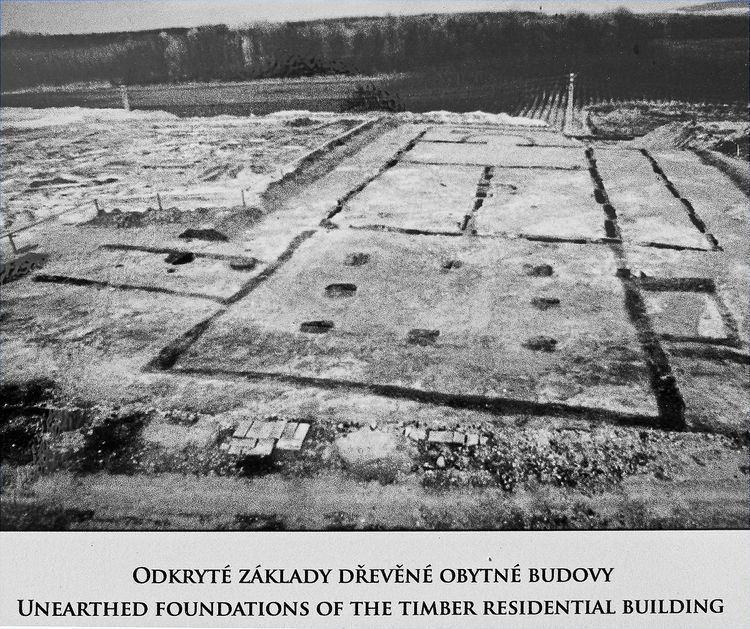Region Marcomania Phone +420 606 472 764 | Type Castrum Period Roman Empire | |
 | ||
Similar Mušov, Kostel svatého L, Oberaden, Haltern, Inchtuthil | ||
The Roman fort (Czech: římská pevnost), also known as German: Burgstall and Czech: Hradisko, is an archaeological site located in Mušov, Czech Republic, of a Roman army camp on the Dyje-Svratka-Jihlava confluence. It was intended to be the capital of the proposed Marcomannia province (Moravia).
Contents
Geography
The site is located on the Dyje-Svratka-Jihlava confluence. It is situated 18 km from Brno and 86 km from Vienna.
History
The castra in Mušov originated as a Roman army camp. Its name is unknown (possibly, but uncertainly, it was Eburon, from Ptolemy's Eβυρον). Romans made it his base of operations in the campaigns against Maroboduus (Marbod). So far the important in the Europe-wide context remains the unique site encompassing large variety of evidences of the period of the Marcomannic Wars (166-180 AD) - the central military base on the hill Hradisko (Hillfort) at Mušov (now cadastral area of Pasohlávky). It was built by the Marcus Aurelius' soldiers deep inside the enemy territory, roughly 86 km to the north of the antique Vindobona (today Vienna). The base covers flat minor hilltop, superelevated by 50 m above surrounding terrain, and its southern mild slopes, on the banks of the river Dyje (Thaya). From this strategically situated location was possible to control and manage crossings of river (fort) and overland routes at the confluence of the rivers Svratka, Svitava and Dyje (Thaya) as well as surrounding areas along the rivers, densely populated by the Germanic tribes of Marcomanii.
Even in Roman times it had a history as a trading center for amber (in analogy as in Carnuntum), brought from the north to traders who sold it in Italy; the main arm of the Amber Road crossed the Danube at Carnuntum and continue on the right bank of Dyje. Marcus Aurelius resided there for short time in the operations time, shortly before his death (180 AD) - during the war against the Marcomanni. During the Barbarian Invasions (reocuppy of the territory - "Eburon" was eventually abandoned and used as a cemetery and source of building material for building projects elsewhere. Eventually, its remains were covered by decaying plant material.
Civilian city
The remains of the civilian city extended around the fortress (on the top). Housing around the upper (real roman) fort was in fact measuring more than 11 square kilometres, lightly fortified, area densely populated by the Germanic tribes of Marcomanni (or Quadi) - (the part of them traded and collaborated with the Romans and enjoyed luxury roman goods). They had the best out of comfort of (partly) civilised life. The area was (of natural development) bounded by left (northern) bank of Dyje river in the south, right (western) bank of Jihlava River in the east and in the north by rectangular plan enclosed V-shaped ditch (and light fence ?). History of this area and its development is probably more older than history of real Roman fort on top of the hill.
Balneum
The inner build-up area of the Roman fortress at Hradisko was uncovered in very limited scale so far. Yet between the years 1926 and 1928 were uncovered unique evidences of antic architecture in the north parts of fortified area by archeologist Anton Gnirs and supported by president Masaryk. Back then discovered enclosure, consisting of residential building with four rooms and baths, considering the war conditions, could be interpreted as luxury residential complex, some sort of ad hoc residence for the highest representatives of military authorities and commanders. Smaller scales of the baths implies rather private use, but there were all necessary rooms including cold and hot water. Baths determined for ordinary Roman soldiers will be at Hillfort (Hradisko) perhaps discovered in the future.
Military camps
In the close surrounding was discovered more than 12 temporary Roman military camps (marching camps). In the seasonal operations (179 AD) was settled there more than 50 000 legionars, mostly from the X. legio - GEMINA PIA FIDELIS
Workshop
On the open area among the buildings were uncovered simple round kilns and one sizable waste pit. This installation served as workshop district, specialized among others to reparations and perhaps simple production of the Roman military equipment and weaponry. This evidence support an idea that inside the fortified area operated certain numbers of civilian personnel under protection of the Roman army. Their sustenance depended on contracts with the Roman army and for that they followed them even in the time of war into the hostile territory
